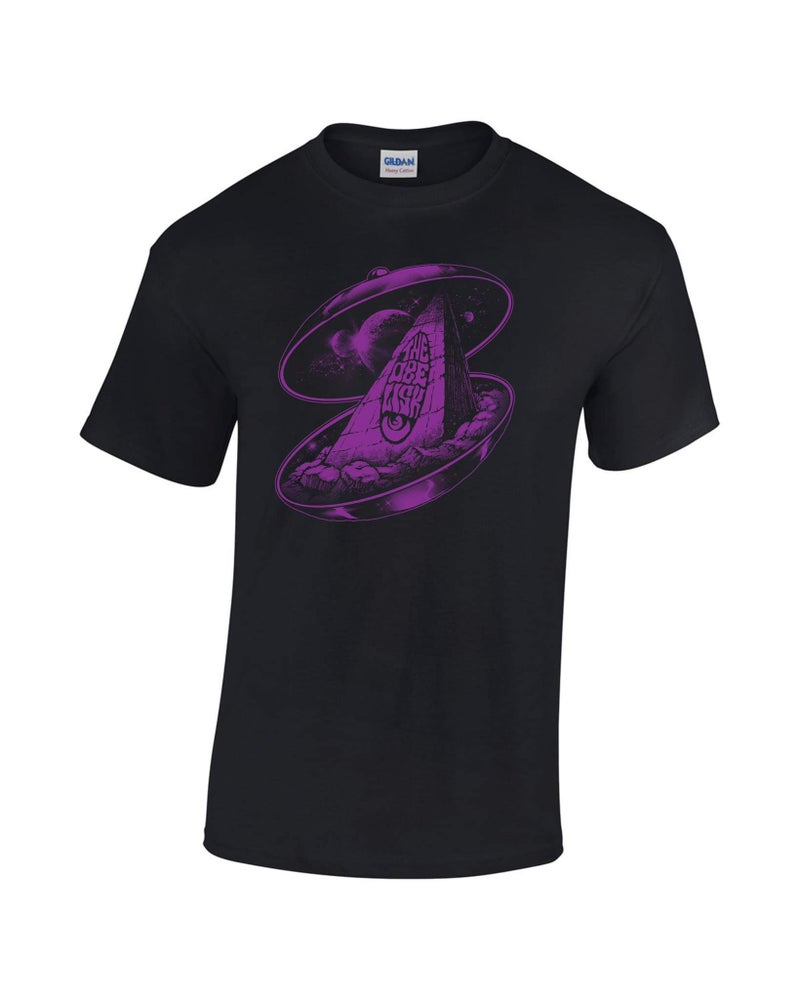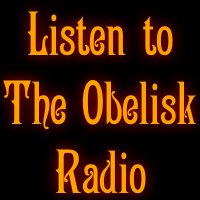The Obelisk Questionnaire: Dave Buschemeyer of Omen Astra
Posted in Questionnaire on January 5th, 2024 by JJ KoczanThe Obelisk Questionnaire is a series of open questions intended to give the answerer an opportunity to explore these ideas and stories from their life as deeply as they choose. Answers can be short or long, and that reveals something in itself, but the most important factor is honesty.
Based on the Proust Questionnaire, the goal over time is to show a diverse range of perspectives as those who take part bring their own points of view to answering the same questions. To see all The Obelisk Questionnaire posts, click here.
Thank you for reading and thanks to all who participate.
The Obelisk Questionnaire: Dave Buschemeyer of Omen Astra
—
How do you define what you do and how did you come to do it?
Hi. My name is Dave Buschemeyer. I am a musician, a printmaker/ artist and have been recently diving into performance art. I play guitar in Omen Astra and have spent time in New Day Rising, Spread The Disease, Die In The Light and a bunch more. I came to make music in the hardcore scene in the early 90’s. It quickly became a passion of mine after being introduced to punk (as a thrash metal head) in the late 80’s and going to see shows in the grimy punk scene in Toronto. Shortly after, I became interested in mixed-media art, went to University for Philosophy and ended up developing a love for print. I am currently back in University to finish a BFA in Print Media with an eye to transitioning to an MFA in either print or Interdisciplinary studies. Inside this very shortened timeline… I was a plumber by trade, which is a very long story.
Describe your first musical memory.
I’m unsure it can be considered the first, because memory is always being changed anytime you think of a thing, but I would say that one of the earliest memories I have is as a child watching my mom sing “Only The Lonely” by Roy Orbison in the kitchen. My mom really loved to sing and Orbison was one of her favorites. Years later, as a teen, my parents asked me to go and see him live in concert with them. I said no. I now recount that as one of those regrettable things you do as a young person that thinks they know some things. Of course, I am now a huge fan of Roy Orbison, and I wish I could go back in time and convince my younger self to stop saying No to everything.
Describe your best musical memory to date.
Best is a tough thing to consider because I strive pretty hard to avoid summing up experiences in a pyramid. However… I will answer it this way… One of my most notable musical memories is seeing Faith No More in 1990 in Mississauga, Ontario. At this show, I got kicked out for stage diving and security wouldn’t let me back in, but by some luck someone affiliated with the band opened the door and motioned to Security to let the few of us standing out there to come back in. We promised profusely not to stage dive anymore… and then quickly made our way to the front to continue. This was probably the one event that set up my love for Faith No More and almost all things Mike Patton.
When was a time when a firmly held belief was tested?
This is a big one for me… as a young adult man I had my ill-informed sense of atheism tested to the core via experiences developed in meditation. In particular, I had a couple “experiences” that made me see just how interconnected all of existence is. This was an incredibly profound shift in my own consciousness that informs who I am today and has sparked a whole printmaking path based on wanting to find ways to visually show something of this inner understanding. Quickly, I recognized that words, being finite packets of meaning, would never be able to show something of the depth of insight as Interconnectedness. So, art being the language of soul and the heart was the closest I could come to doing so. When it comes to music, I am always trying to write something cohesive and final, something closed, something that feels complete and whole. The closest I have come to that is the Omen Astra album. For me, it is a high water mark in my creative music making because it feels the most resolved and completed. I am very fond of that record.
Where do you feel artistic progression leads?
Artistic progression either leads one of two ways. An artist is either singular-minded and decides to forge a path based on their ideological assumptions, or an artist is open to existence and allows the dizzying depths of it to inform them of their path. In this, I am describing stages of how I have approached making creative work. There was a point where I realized that performing an action ideologically, or for ideological reasons, was somehow less important or felt less meaningful than if I made work based on what is bubbling up in me in the moment. Without going into it too much, I am starting to find that art that is based on ideology is often boring and rarely gets me to ask more questions of the work. But art that comes from a sense of openness and free play, and originates from a place of curiosity is often art that has me looking deeper. The first kind of art, as I see it, is making statements about the world, and comes from a place of supposed knowing. The second kind is art that comes from a place of openness and wonder. It is this second kind that I am often drawn to. So, an ideologically driven person will make statements like “you cannot take the politics out of art”. A more nuanced and “open” artist may say “There are political ramifications in everything, but I choose not to engage in that because it only says something about the social realm… whereas I am attempting to talk about the feel of a snowflake on the tip of my tongue.”
How do you define success?
I have no specific definition of success, except that for me if it feels right, and everything is aligning after all of the effort, then it is successful.
What is something you have seen that you wish you hadn’t?
I have witnessed a couple people die in front of me. And there have been times where I wish I was spared that somehow, but I’m honestly of a different mind now. I think those experiences have served to give me a much greater appreciation for people and life. I try to say Thank You, and to smile, and to be helpful as much as possible… all because I’ve seen just how short and tragic human existence can be. I guess the answer is… at this point in my progression there isn’t anything I wish I hadn’t seen/ witnessed.
Describe something you haven’t created yet that you’d like to create.
I have this notion that at some point I will make some visual representation of my experiences in meditation that will be so compelling and so profoundly understood that I will no longer wish to keep creating because no better example is possible. Of course, I do realize that this will never happen, but at some point, this became heavy motivation for me to keep trying new things in my print practice in order to discover some new way of communicating it. In writing this out, I am struck by just how romantic this sounds… and also possibly how futile it really is.
What do you believe is the most essential function of art?
Art is a mirror for the soul. It’s most essential function is to draw out those key qualities in human existence that transcend ephemerality…. At heart, I suppose I am a Platonist. For me, the reason why great art talks to us is because on some level it’s tickling at an understanding that is already within us. And so the role of art in this way is to show our deepest, truest selves to ourselves. It is very fashionable to talk about Ephemerality and to assume that change is the nature of the entirety of existence. But, for me, when you’re art is about a pre-ephemeral state of being, about something that stands resolutely outside of change and decay, I have to reject it as a fundamental, but keep working within it to show it’s opposite. Dont’ get me wrong… ephemerality is the playstuff of the artist. I lean into it without even recognizing it, but ultimately I am always striving to say something lasting. And perhaps it is the striving itself that outlasts. I am aware that these ideas fly in the face of post-modernism and I wrestle a lot with the contradiction and feel like I’m a man displaced out of his rightful time. LOL
Something non-musical that you’re looking forward to?
I am looking forward to art openings, record releases and any other creative thing I can get my hands into. Thank you for this interview.
LINK TREE- https://linktr.ee/davebuschemeyer
WEBSITE- https://www.davebuschemeyer.com/
PERFORMANCE- https://vimeo.com/davebuschemeyer
INSTA MUSIC- https://www.instagram.com/davebuschemeyer_music/
INSTA ART- https://www.instagram.com/davebuschemeyer_artist/
PERSONAL BC- https://davebuschemeyer.bandcamp.com/
OMEN ASTRA BC- https://omenastra.bandcamp.com/
SPREAD THE DISEASE BC- https://spreadthedisease.bandcamp.com/
NEW DAY RISING BC- https://newdayrising-hardcoreband.bandcamp.com/
DIE IN THE LIGHT BC- https://dieinthelight.bandcamp.com/
THOUGHT WAVE BC- https://thoughtwave.bandcamp.com/
THE CHINA WHITE BC- https://thechinawhite.bandcamp.com/album/the-gun-of-the-enemy
THE ABANDONED HEARTS CLUB BC- https://theabandonedheartsclub1.bandcamp.com/
THE FORMLESS FORM BC- https://formlessform.bandcamp.com/album/stillest-embrace
WITHOUT LUNGS BC- https://withoutlungs.bandcamp.com/album/simpler-times-ep
http://linktr.ee/omenastra
http://www.instagram.com/omen_astra
http://www.facebook.com/omenastra
http://linktr.ee/hypaethralrecords
http://instagram.com/hypaethralrecords
http://www.facebook.com/hypaethralrecords
http://www.instagram.com/protaginc
http://www.instagram.com/momentofcollapserecords






